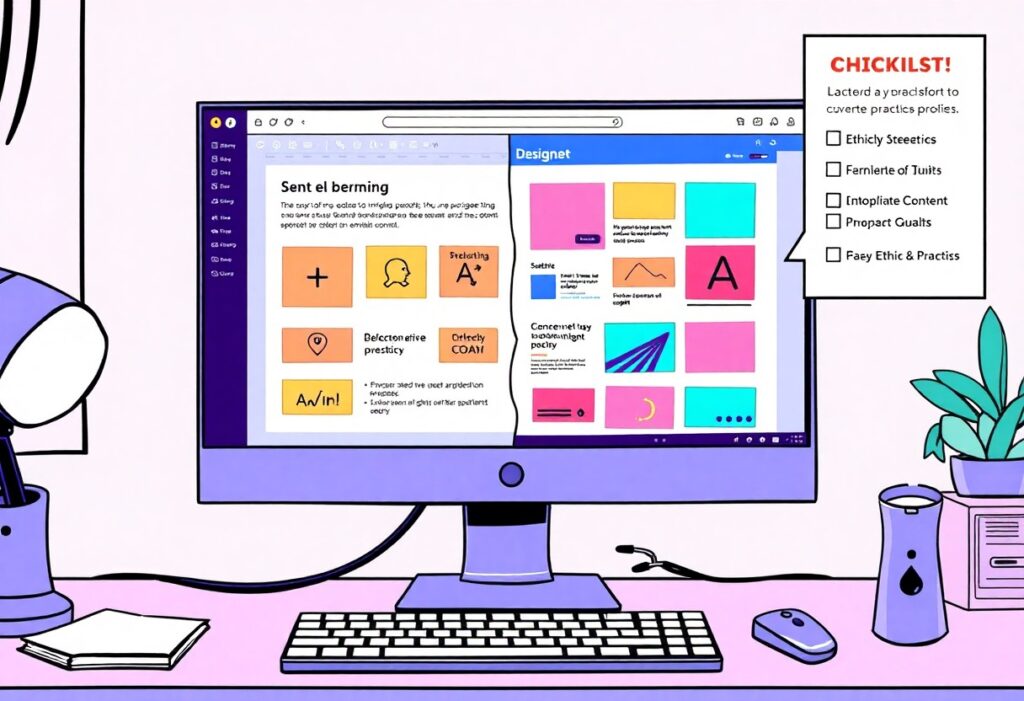Most website creators are looking for ways to enhance their workflow and ensure ethical practices in content creation. Utilizing Elementor AI can help you streamline your design process while maintaining quality and integrity. In this guide, you’ll learn how to harness the power of AI for sustainable content generation and responsible design automation. By following these steps, you can create engaging, ethical web experiences that resonate with your audience.
Harnessing AI: Crafting Engaging Content with Elementor
Leveraging AI-Powered Text Generation
Utilizing AI-powered text generation through Elementor allows you to produce high-quality content quickly and efficiently. By integrating AI tools like GPT-3 into your design workflow, you can create captivating blog posts, product descriptions, or landing page copy in a fraction of the time it usually takes. This not only increases your productivity but allows you to focus on other critical aspects of your design and marketing strategies. You’ll find that the AI can generate suggestions based on your previous content, maintaining a consistent tone and style across various platforms and formats.
Implementing this functionality gives you flexibility and adaptability in your content creation process. For instance, if you’re an e-commerce site owner, you might need different types of content for different categories. AI can analyze customer preferences and generate tailored copy that resonates with specific audiences, ultimately enhancing user engagement and conversion rates. By allowing AI to do the heavy lifting in drafting initial content, you can fine-tune and polish the final output to align perfectly with your brand’s voice.
Optimizing SEO with Automated Content Suggestions
The realm of SEO can be complex, but Elementor’s AI-driven tools simplify optimization through automated content suggestions. As you craft your content, the AI assesses keyword distribution, readability, and structural flow, offering real-time feedback that helps improve your chances of ranking higher. Incorporating these suggestions ensures you’re targeting the right audience with the right messages while adhering to SEO best practices. For example, when you write an article about “sustainable design,” the AI might suggest relevant long-tail keywords you hadn’t considered, leading to an increase in organic traffic.
Automated suggestions further extend to structuring your article with headings, subheadings, and bullet points that enhance readability—elements that search engines favor. You can confidently build a comprehensive content strategy that integrates user intent with effective SEO, leading to heightened visibility across search engines. Furthermore, consistent optimization elevates your site’s performance analytics, improving dwell times and decreasing bounce rates, all of which are critical indicators of your content’s effectiveness.
Engaging with these automated suggestions allows you to iteratively refine your content for both user engagement and SEO performance. By consistently tweaking and optimizing your topics based on data-driven insights, you can focus on producing relevant, impactful content that connects with your audience while reinforcing your site’s authority in your niche.
Streamlining Design: Automating Aesthetic Choices
Harnessing the power of Elementor’s AI capabilities allows you to expedite your design processes, focusing on what truly matters—creating an attractive and functional website for your audience. By automating aesthetic choices, you can achieve a balanced look across your site while significantly reducing the time spent on manual adjustments. Whether you’re designing for a client or your own project, consistency in design is key to retaining user interest and driving conversions.
Utilizing AI for Smart Layout Recommendations
AI-driven smart layout recommendations provided by Elementor can simplify your decision-making in layout design. The AI analyzes the content you input and suggests optimal arrangements that enhance readability and visual appeal. For example, if you add a series of images and text, Elementor’s AI evaluates their dimensions and content relationships, offering layout suggestions that bring harmony and flow to your page. This means you can effortlessly create professional-looking pages without needing extensive design knowledge.
Choosing Color Palettes and Typography through AI Insights
Selecting the right color palette and typography can significantly influence your website’s overall feel and effectiveness. Elementor’s AI analyzes color theory principles and design trends to propose color schemes that resonate with your brand identity while ensuring accessibility. The tool considers factors such as color contrast and harmony, helping prevent common design pitfalls. Typography is equally imperative; the AI recommends fonts that work well together, considering readability and emotional impact, allowing you to craft a cohesive reading experience.
Incorporating AI insights into your color and typography choices isn’t just about aesthetics; it’s a strategic enhancement. For instance, a website aiming to evoke trust might benefit from cooler colors like blue, while a creative portfolio could thrive with a more vibrant palette. By deploying the AI’s recommendations, you align your choices with established psychological principles, increasing the likelihood of user engagement and satisfaction. This smart approach to aesthetic decisions takes away the guesswork, enabling you to make informed choices that support your overall design goals.
Ethical Guidelines: Balancing Automation with Authenticity
Recognizing the Boundaries of AI Use
Understanding the limits of AI in content creation is important for maintaining ethical standards. While Elementor AI can provide you with tools to generate quick and efficient content, it lacks the nuanced understanding of human emotions and cultural contexts that resonates with your audience. For instance, relying solely on AI-generated texts could lead to a disjointed narrative or a tone that feels impersonal. To navigate this challenge, establish clear boundaries around when and how you’ll incorporate AI-generated content. By using it as a supportive tool rather than a primary creator, you preserve the human touch that your brand is known for.
Implementing a feedback loop can help you measure how AI aligns with your audience’s expectations. Regularly analyze engagement metrics and customer feedback to adjust your strategy accordingly. A well-defined framework will help you recognize when AI should take a back seat, ensuring that your content remains authentic and relevant.
Best Practices for Maintaining Brand Voice and Integrity
To uphold your brand voice while leveraging AI automation, develop comprehensive guidelines that reflect your core values and communication style. Start by distilling your brand’s personality into a style guide that outlines tone, terminology, and messaging strategies. This reference will assist you in editing AI-generated content to conform to your unique voice, mitigating the risk of a robotic or generic output. For instance, if your brand is conversational and friendly, make it a point to adjust formal wording or technical jargon that AI might produce.
Engaging in a collaborative editing process with your team encourages the infusion of human insights into the overall content creation process. Furthermore, incorporating human oversight acts as a safeguard against potential ethical pitfalls, ensuring your messaging remains on-brand. Regularly check your AI-generated outputs against your style guide, adjusting language and tone to reflect your brand’s mission and values. This way, you empower AI to serve your authenticity rather than overshadow it.
Continual training and updates to your style guide will also reinforce brand integrity. As your audience evolves, so too should your content approach. Regularly revisit the guidelines to account for feedback and emerging trends. Both manual and automated processes benefit from ongoing refinement, allowing you to maintain a cohesive voice while embracing the efficiencies that AI offers. By actively managing these best practices, you can confidently navigate the intersection of technology and authenticity.
Troubleshooting Common Pitfalls: Ensuring Quality Control
Identifying and Addressing AI Missteps
AI tools, while powerful, are not infallible. You may encounter instances where the generated content doesn’t quite hit the mark. This could manifest as factual inaccuracies, inappropriate tone, or even grammatical errors. Conducting regular audits of the AI-generated outputs can help you flag these issues early. Use feedback loops, allowing you to tweak parameters and guide the AI towards better results. Creating a checklist of common pitfalls—like checking for relevance, coherence, and grammar—can help streamline this process.
Incorporating human oversight is vital. Consider assembling a small team of reviewers who can provide constructive feedback on the content generated. They should focus not only on correcting errors but also on evaluating the creative aspects of the content. This dual approach ensures that you maintain both accuracy and engagement in what you share.
Implementing Review Processes for Automated Content
Establishing a robust review process transforms AI-generated material from a simple draft into a polished piece of content. Start by defining clear guidelines for what constitutes quality work in your context. These standards might include style, tone, and the level of detail required. Pairing AI outputs with an editorial schedule can make this ongoing process more manageable and effective.
A core component of your review process should involve regular checkpoints to assess the content’s alignment with your brand voice and objectives. Encourage your team to engage in discussions about findings during review meetings, ensuring that everyone is aligned on both the goals and the standards of the content produced. This inclusive approach leads not only to enhanced content quality but also fosters a collaborative atmosphere within your workflow.
Future-Proofing Your Workflow: Adapting to AI Advances
Staying Updated with Elementor AI Innovations
Navigating the rapidly changing landscape of AI technology requires a proactive approach to stay ahead. Elementor frequently rolls out updates that not only enhance performance but also introduce new features to leverage AI capabilities more effectively. Subscribing to Elementor’s newsletters or following their official blog is an excellent way to keep your finger on the pulse of these developments. Engaging with the Elementor community through forums or social media can also provide you with insights into real-world applications and tips directly from other users. Participating in webinars or workshops offered by the team can further enrich your understanding of how to implement these innovations in your workflow efficiently.
Planning for Evolving Content Strategies
Content strategies must be dynamic and adaptable, especially as AI technology continues to evolve. Utilizing Elementor AI, you can enhance your content delivery and engagement through smart automation tools, ensuring that you stay relevant in a fast-paced digital landscape. Examining consumer behavior data and utilizing AI-driven analytics tools will help in tailoring content that resonates with your target audience, enhancing user experience and driving conversions. Regularly revisiting your content strategy—ideally on a quarterly basis—will allow you to integrate new AI features, ensuring that your approach remains aligned with industry standards and user expectations.
Considering the rapid advancements in technology, adjust your content planning by incorporating AI tools that analyze trends and predict user preferences. By experimenting with various formats and channels, you can identify which combinations yield the best results. Whether it’s creating dynamic landing pages, personalized email campaigns, or more interactive content types, leveraging AI insights will significantly assist in your strategic decision-making process, positioning you to capitalize on future opportunities.
Summing up
To wrap up, utilizing Elementor AI for ethical content and design automation can significantly enhance your workflow while maintaining integrity in your projects. By leveraging its tools, you can streamline your design processes, create visually appealing content, and ensure that your work aligns with ethical standards. As you navigate this powerful platform, be thoughtful in your approach, ensuring that your automated content genuinely reflects your brand values and resonates with your audience.
Moreover, it’s necessary to stay informed about the latest features and best practices within Elementor AI to maximize its benefits. Regularly updating your knowledge will enable you to adopt innovations that enhance both your content and design effectively. By integrating these practices into your routine, you’ll not only improve your productivity but also contribute to a more responsible and ethical online environment.
Summing Up: Enhancing Workflow with Ethical Elementor AI Automation
Q: What is Elementor AI and how can it assist in content creation?
A: Elementor AI is an advanced feature integrated into the Elementor page builder that utilizes artificial intelligence to help users generate content and design elements automatically. By leveraging AI, users can save time on repetitive tasks such as writing text or suggesting layouts, allowing them to focus on creating engaging and effective content. By inputting specific prompts or keywords, Elementor AI can generate relevant content suggestions, design recommendations, and even optimize existing content for better user engagement.
Q: How can Elementor AI be used ethically in my content and design projects?
A: Utilizing Elementor AI ethically involves several key practices. First, ensure that all AI-generated content is reviewed for accuracy and relevance, as AI may occasionally produce misinformation or content that doesn’t align perfectly with your brand voice. Additionally, always provide proper attribution for any resources or data that are sourced externally. Finally, prioritize transparency with your audience by disclosing when content has been autogenerated or significantly influenced by AI, fostering trust and integrity in your work.
Q: Are there any limitations to using Elementor AI for design automation?
A: While Elementor AI offers amazing capabilities for content generation and design automation, it does have limitations. The AI-generated content may lack the nuance and creativity that a human touch can provide, especially in more specialized or niche topics. Additionally, design suggestions may not always align perfectly with your brand identity or specific requirements, so manual adjustments may still be necessary. It’s imperative to strike a balance, using AI-generated elements as a starting point and applying your personal expertise to refine and finalize the designs and content.



